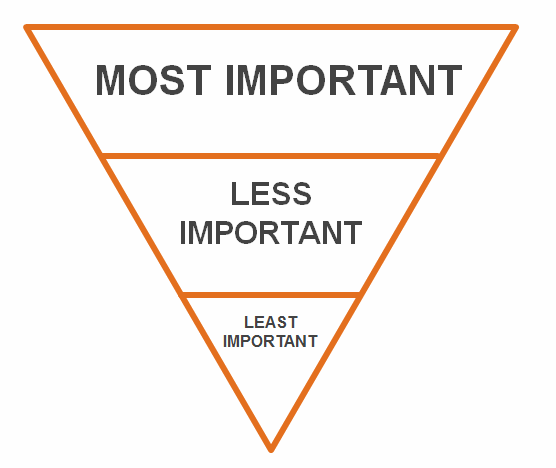Why the Inverted Pyramid Doesn't Work for Business Blogs
Why the Inverted Pyramid Doesn't Work for Business Blogs:
from HubSpot's Inbound Internet Marketing Blog
 As a blogger, I try to follow the motto that “you are what you eat.” (No, I don’t go around eating computers parts or snacking on pieces of paper.) I firmly believe that if you want to be a great writer, you should read amazing content by writers you admire. To make sure I’m at the top of my writing game, I read. A lot. Like, a lot a lot.
As a blogger, I try to follow the motto that “you are what you eat.” (No, I don’t go around eating computers parts or snacking on pieces of paper.) I firmly believe that if you want to be a great writer, you should read amazing content by writers you admire. To make sure I’m at the top of my writing game, I read. A lot. Like, a lot a lot.
One of the blogs I really admire is the KISSmetrics blog -- it consistently features very well written and researched posts that make me think. This week was no different. I came across a post that made me think -- and then spurred me to write this post.
In the post, author Adam de Jong presents 10 marketing lessons he learned in journalism school. One caught my eye. He suggests that marketers should take a page out of journalists’ book and write in the style of the inverted pyramid -- a structure of writing where you provide the most important information in the first paragraph or two, and then reveal increasingly less important information as the article progresses. It’s the go-to story format for reporters today.
And I had a realization … I have never written a blog post in the style of the inverted pyramid. Does that make me a bad writer or bad marketer? Or is the inverted pyramid format an outdated storytelling format for business bloggers and marketing content creators today?
To tackle this dilemma, I did some digging, and here’s what I found. Before we start accusing writing formats of being entirely right or wrong, let’s take a look at the history of the inverted pyramid.
What is the inverted pyramid?
Although many historians disagree about why the inverted pyramid was invented, they know it all began when we started relying on the telegraph to communicate. The telegraph was very expensive to use, and there was always a possibility that the wires transmitting could be cut -- so newspaper reporters began transmitting messages in the inverted pyramid style. In this style of writing, the most important information (usually the 5 W's) is contained in the first few paragraphs. Each following paragraph has less important information than the paragraph before it. Here's essentially what it looks like:
Newspaper editors also loved the inverted pyramid because they could simply cut content from the bottom of a story without losing critical story information if they needed to shorten a piece.
The inverted pyramid model was the most popular media format throughout the 20th century since print ruled the media -- and it has continued to be the gold standard for online formats as well. When people started writing online for marketing purposes, the inverted pyramid style stuck, even though the medium had changed drastically.
Now, marketers publish on unlimited space, compete for readers’ attention with the near-limitless content on the web, and use content to convert visitors into leads.
Still … somehow, we assumed this format was the best way for marketers to transmit information online to convert visitors into leads. But it’s not -- we have data to prove it. Here’s why the inverted pyramid doesn't work for marketers.
Why doesn’t the inverted pyramid work for online marketing content?
Thanks to good ole hard data, we’ve uncovered one big reason why the inverted pyramid isn’t always the best option for using online content for marketing.People don’t consume information in the way the inverted pyramid presents it.
Most people don’t drop off after the first sentence -- they actually read (or scan) a decent chunk of your article before dropping off. According to an eye-tracking study by Nielsen, most people read in an “F” pattern online, which basically translates to horizontal movement, followed by vertical, scanning movement down the web page. Then readers make another horizontal movement and then scan all the way down the left side of the page. Here’s what it looks like:
In another study from Poynter, online participants who actively read content online and in print were asked to choose a story to read in several different formats -- online, broadsheet (print newspapers), and tabloid. According to the study, participants read an average of 77% of the online story they chose to read -- considerably higher than broadsheet’s 62% and tabloid’s 57%.
These results held up across all story lengths. “From 1 to 4 inches for the shortest stories to those 19 inches and longer -- we found that online readers still read more text regardless of the length,” the study reported.
This study's findings were also reproduced in a recent Chartbeat study of Slate articles. According to the study, the majority of readers got through 60% of the articles -- which is much more than the first few paragraphs.
What all this translates to is people reading more content than just the first paragraph or two -- they’re reading or scanning big chunks of your article to see if there’s relevant, digestible information.
So while the inverted pyramid technique may work for news formats, there's evidence suggesting it's not the right format for a lot of the content we marketers make -- which likely includes lots of evergreen content that teach something to our audiences. So there is hope for those of us (including me) who don’t give away the whole story in the first paragraph! In our type of content, you need to hook someone into your article through the first couple of paragraphs, but you shouldn’t give your whole story away immediately.
When reading business blog posts, people need to be hungry for more content after reading the introduction, not satiated with the information from a few sentences. With the inverted pyramid model, there’s no impetus for readers to keep scrolling. They've already learned all the information they need to know in the first paragraph or two. To keep them reading, there should be valuable information presented again and again through the entire article, all the way to the post's ultimate destination: the call-to-action at the bottom.
The inverted pyramid model isn’t optimized to retain readers’ attention and drive conversions -- but there are quite a few other story formats that are.
What can you use instead of an inverted pyramid?
Have no fear! You have lots of other story formats to use on your business blog. Here are just a few that work well on business blogs (complete with some semi-funky names we came up with):- The Pyramid: This is a step-by-step guide that shows you how to complete a task. Each concept builds on the last, so that only at the end of the post do you have a vision of the whole story. An example of this type of post on the HubSpot blog is How to Create a Facebook Business Page in 5 Simple Steps (With Video).
- The List: You see list posts all over the internet: “Top 10 Reasons Why You Should Be on Facebook” or “7 Reasons Why The Bachelorette is the Best Show of All Time.” And readers love them! If you’d like to see an example of one we’ve done, check out "The Top 10 Qualities of High-Quality List Posts." (See what we did there?)
- The Yin & Yang: These types of posts are the ones that group concepts according to problems and quickly provide solutions. They may also appear within list posts (think “Top 5 Problems Sales Teams Have – With Solutions on How to Fix Them!”), but you’ll recognize these posts by the back-and-forth arguments they feature. We recently featured this type of post on our blog in "How 7 Experts Solve Their Most Painful Email Marketing Problems."
- The LEGO: In this format, you’ll present one big idea right off the bat, and then break it apart into individual concepts to explain the overall concept in depth. To see this type of post in action on the HubSpot blog, check out "How to Write the Worst Guest Blogging Pitch of All Time [Template]."
So you shouldn't feel like a bad marketer if you don't use the inverted pyramid -- it wasn't created for online marketing content. Dan Lyons, a colleague of mine who came from the traditional journalism world, agrees. “The inverted pyramid was created to meet the demands of print media and for telling a certain kind of news story," he says. "It's a great thing to know, and it can be useful, but it's not always the best way to write a blog post."
If you want to use your blog to push your business forward, the inverted pyramid probably isn't the best way to go. Instead, entice readers to read -- and convert on -- your blog content through an interesting introduction followed by engaging and scannable content. Your bottom line will thank you for it.
What do you think? Do you think the inverted pyramid model is outdated for business blogs today? Share your thoughts with us in the comments.
Image credit: djwtwo




No comments:
Post a Comment